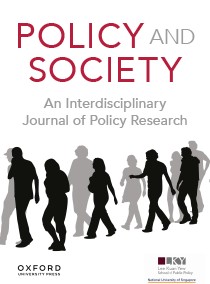要构建一个政策变革的联盟,需要(不)模棱两可的是什么?来自韩国“儿童保育公共性”改革的证据
IF 6.1
1区 社会学
Q1 POLITICAL SCIENCE
引用次数: 0
摘要
对不同的人有不同含义的想法越来越多地被研究为具有广泛吸引力,但政策企业家如何具体利用模糊性来构建政策变革联盟仍不清楚。从概念上讲,本文根据概括性揭示了不同层次的想法,并在此基础上确定了两种模糊性构建策略:使问题定义模糊,以团结具有不同解决问题兴趣的异质行为者;或明确定义问题,同时故意使解决方案模糊,以适应不同行为者的各种政策建议。从经验上比较了两届韩国政府对模糊的育儿公共性概念的不同运用。本研究的关键是关注这两种不同的模糊构建策略如何影响联盟的规模和凝聚力,从而影响政策制定过程。在这样做的过程中,本文提供了一个更丰富的理解概念歧义作为一个非整体属性。本文章由计算机程序翻译,如有差异,请以英文原文为准。
What needs to be (un)ambiguous to construct a coalition for policy change? Evidence from South Korea’s “childcare publicness” reforms
Ideas meaning different things to different people have increasingly been studied as possessing a broad appeal, but it remains unclear how specifically policy entrepreneurs can utilize ambiguity to construct a coalition for policy change. Conceptually, this article unravels the different levels of ideas according to generality, based on which it identifies two ambiguity-building strategies: making problem definitions ambiguous to rally heterogeneous actors with different problem-solving interests or defining the problem clearly, while deliberately leaving the solution ambiguous to accommodate various policy proposals from diverse actors. Empirically, it compares and contrasts two South Korean governments where the ambiguous idea of childcare publicness was utilized differently. The crux of this research focuses on how these two different ambiguity-building strategies can affect the coalition’s size and cohesion, and thereby shape the policymaking process. In doing so, this article provides a richer understanding of ideational ambiguity as a non-monolithic property.
求助全文
通过发布文献求助,成功后即可免费获取论文全文。
去求助
来源期刊

Policy and Society
Multiple-
CiteScore
18.00
自引率
6.50%
发文量
43
审稿时长
30 weeks
期刊介绍:
Policy and Society is a prominent international open-access journal publishing peer-reviewed research on critical issues in policy theory and practice across local, national, and international levels. The journal seeks to comprehend the origin, functioning, and implications of policies within broader political, social, and economic contexts. It publishes themed issues regularly and, starting in 2023, will also feature non-themed individual submissions.
 求助内容:
求助内容: 应助结果提醒方式:
应助结果提醒方式:


